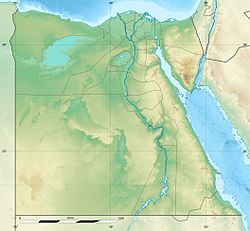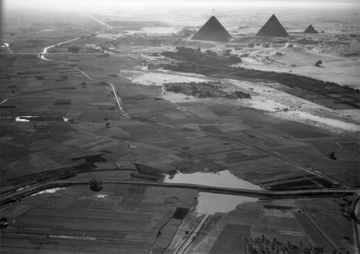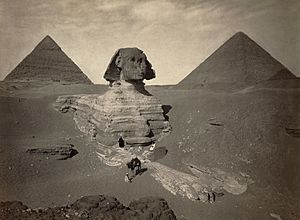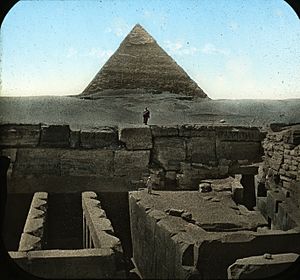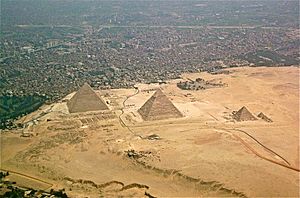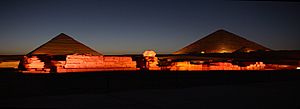Giza pyramid complex facts for kids
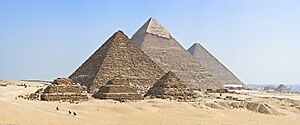
The three main pyramids at Giza, with smaller pyramids and other ancient buildings.
|
|
| Location | Giza, Greater Cairo, Egypt |
|---|---|
| Region | Middle Egypt |
| Coordinates | 29°58′34″N 31°7′58″E / 29.97611°N 31.13278°E |
| Type | Monument |
| History | |
| Periods | Early Dynastic Period to Late Period |
| Site notes | |
| Website | |
| UNESCO World Heritage Site | |
| Part of | "Pyramid fields from Giza to Dahshur" part of Memphis and its Necropolis – the Pyramid Fields from Giza to Dahshur |
| Includes |
|
| Criteria | Cultural: i, iii, vi |
| Inscription | 1979 (3rd Session) |
| Area | 16,203.36 ha (162.0336 km2; 62.5615 sq mi) |
The Giza pyramid complex, also known as the Giza necropolis, is a famous archaeological site in Egypt. It is home to three huge pyramids: the Great Pyramid, the Pyramid of Khafre, and the Pyramid of Menkaure. The mysterious Great Sphinx also stands guard here.
These amazing structures were all built during the Fourth Dynasty of the Old Kingdom of ancient Egypt, around 4,500 years ago (between 2600 and 2500 BC). The site also has smaller temples, cemeteries, and the ruins of a village where the pyramid builders lived.
The complex is located on the edge of the Western Desert, about 9 kilometers (5.6 miles) west of the Nile River. It is part of a larger UNESCO World Heritage Site called Memphis and its Necropolis, which protects the many pyramids near Egypt's ancient capital, Memphis.
The Great Pyramid and the Pyramid of Khafre are the largest pyramids ever built in ancient Egypt. The Great Pyramid was so impressive that it was named one of the Seven Wonders of the Ancient World. Today, it is the only one of these ancient wonders that still exists.
Contents
The Main Monuments
The Giza pyramid complex includes several incredible structures that have fascinated people for thousands of years. The most famous are the three large pyramids and the Great Sphinx.
Khufu's Great Pyramid
The largest pyramid at Giza belongs to the pharaoh Khufu (also known as Cheops). It was built between 2580 and 2560 BC. His complex included a valley temple, a long walkway called a causeway, and a mortuary temple right next to the pyramid. Today, only the stone pavement of the temple remains.
Around the Great Pyramid are three smaller pyramids built for queens. Archaeologists also found pits that once held large wooden boats. One of these, the Khufu ship, was carefully put back together and is now displayed in the Grand Egyptian Museum.
The Great Pyramid was once covered in smooth, white limestone casing stones, which would have made it shine brightly in the sun. Only a few of these stones are left at the pyramid's base.
Khafre's Pyramid and the Sphinx
The second-largest pyramid was built for Khufu's son, Khafre (or Chephren). It looks taller than the Great Pyramid because it was built on higher ground and has a steeper angle. A special feature of Khafre's pyramid is that some of its original polished casing stones are still visible at the very top.
Khafre's complex also had a valley temple, a causeway, and a mortuary temple. Many statues of Khafre were discovered in his valley temple.
Most experts believe that the Great Sphinx, a huge statue with the body of a lion and the head of a human, was also built for Khafre. Its face is thought to be a portrait of the pharaoh himself. The Sphinx is located on the east side of the complex, near Khafre's causeway.
Menkaure's Pyramid
The third and smallest of the main pyramids belongs to Menkaure (or Mykerinos), who was Khafre's son. It was finished around 2510 BC. Like the other pharaohs, Menkaure had a valley temple, a causeway, and a mortuary temple. His pyramid complex also includes three smaller queens' pyramids.
Today, Menkaure's pyramid is the only one of the three that does not have any of its original polished limestone casing.
How Were the Pyramids Built?
Building the pyramids was a massive project. Most experts agree that workers moved huge stone blocks from quarries, then dragged and lifted them into place. How they lifted the heavy stones is still debated. They may have used long ramps that wrapped around the pyramid as it grew taller.
First, the builders chose a flat, rocky area for a strong foundation. They cut most of the inner stones from a quarry right next to the construction site.
The smooth outer casing stones were made of a special white limestone from a quarry in Tura, across the Nile River. These blocks were cut perfectly, carried by boat to Giza, and then pulled up ramps. To make sure the pyramid's sides were straight and even, each block had to be the same height and width.
Why Were the Pyramids Built?
The pyramids were built as magnificent tombs for the pharaohs. The ancient Egyptians believed that a part of the pharaoh's spirit, called the ka, stayed with the body after death.
To protect the pharaoh's body and help him on his journey to the afterlife, he was mummified and placed inside the pyramid. The pyramid also served as a storage place for all the treasures and items the pharaoh would need in the next world.
The Workers' Village
Building the pyramids required thousands of skilled workers and laborers. These were not slaves, as many people used to believe. They were paid workers who took pride in their work.
Archaeologists discovered a town near the pyramids where the workers lived. This village had bakeries, breweries, kitchens, and sleeping areas. They even found a hospital and a cemetery for the workers. Skeletons found there showed injuries that could have happened on a large construction site.
Evidence suggests that about 10,000 workers, working in three-month shifts, took around 30 years to build one pyramid. The town seems to have been built during the reigns of Khafre and Menkaure.
Cemeteries at Giza
As the great pyramids were being built, smaller tombs called mastabas were constructed around them for other members of the royal family and high-ranking officials. These tombs were laid out in organized cemeteries with streets and avenues.
- East Field:* Located east of Khufu's pyramid, this cemetery contains the tombs of his wives, sons, and daughters. The tomb of Queen Hetepheres I, Khufu's mother, was also found here.
- West Field:* This large cemetery to the west of Khufu's pyramid holds the tombs of important officials, including some of Khufu's sons who served as viziers (high-ranking advisors).
- Tombs of the Pyramid Builders:* In 1990, the tombs of the pyramid workers were found. They were buried in simple mudbrick tombs with bread and beer for the afterlife. This discovery helped prove they were respected laborers, not slaves.
Giza in Later Times
Giza remained an important site long after the Old Kingdom. During the New Kingdom (about 1,000 years later), pharaohs came to honor the ancient monuments.
- Thutmose IV, a prince at the time, fell asleep near the Sphinx. He dreamed that the Sphinx promised he would become pharaoh if he cleared away the sand that had buried its body. When he became king, he did just that and placed a large stone slab, called the Dream Stele, between the Sphinx's paws to tell the story.
- Pharaohs like Amenhotep II and Ramesses II also built small temples and monuments at Giza. Even Tutankhamun had a small building constructed there.
Modern Giza
Today, the Giza pyramid complex is one of the most famous tourist destinations in the world. Millions of people visit each year to see the ancient wonders.
The site has also been used for modern events. In 2007, the singer Shakira performed for a crowd of about 100,000 people there.
To make the site more visitor-friendly, the Egyptian government completed a major renovation project. The updates included a new visitor center, electric buses to reduce pollution, restaurants, and better facilities for tourists.
Images for kids
See also
 In Spanish: Necrópolis de Guiza para niños
In Spanish: Necrópolis de Guiza para niños
- Egyptian pyramids
- List of Egyptian pyramids
- Outline of Egypt


